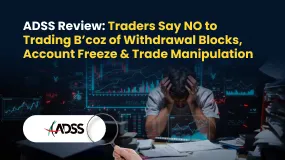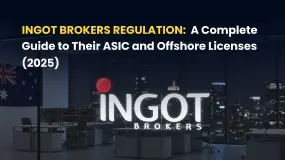简体中文
繁體中文
English
Pусский
日本語
ภาษาไทย
Tiếng Việt
Bahasa Indonesia
Español
हिन्दी
Filippiiniläinen
Français
Deutsch
Português
Türkçe
한국어
العربية
Deepfake Deception: New Face of Financial Scams in Forex and Crypto
Abstract:In the ever-evolving landscape of financial scams, fraudsters are now leveraging cutting-edge artificial intelligence (AI) to deceive unsuspecting victims. Deepfake technology, which manipulates audio and video to create hyper-realistic but entirely fabricated content, has become a powerful tool for scammers, particularly in the forex and cryptocurrency markets.

In the ever-evolving landscape of financial scams, fraudsters are now leveraging cutting-edge artificial intelligence (AI) to deceive unsuspecting victims. Deepfake technology, which manipulates audio and video to create hyper-realistic but entirely fabricated content, has become a powerful tool for scammers, particularly in the forex and cryptocurrency markets. These scams often involve impersonating well-known figures, creating fake endorsements, or even fabricating entire investment webinars to lure traders into fraudulent schemes.

Deepfake scams in the financial industry typically follow a well-crafted script. Scammers use AI-generated videos to impersonate reputable figures—such as CEOs of brokerage firms, famous traders, or financial analysts—to endorse fraudulent investment opportunities. These manipulated videos are often distributed through social media platforms, WhatsApp groups, or even directly via email campaigns.
One common tactic involves deepfake videos of financial influencers or industry leaders “promoting” a trading platform with promises of guaranteed high returns. Some fraudsters go as far as staging live video calls, where victims believe they are interacting with a real person, when in fact, it is an AI-generated deepfake controlled by the scammer. This level of deception adds a layer of credibility that traditional scams could never achieve, making it increasingly difficult for traders to differentiate reality from fiction.
Recognising deepfake scams requires vigilance and an understanding of the subtle inconsistencies that AI-generated content often exhibits. One of the most common red flags is unnatural facial movements. Deepfake videos may struggle to replicate natural eye movements, blinking patterns, or lip synchronisation when speaking. If something about the facial expressions or the way a person moves appears slightly off, it is worth investigating further.
The voice in a deepfake video can also provide clues. While AI-generated voices have improved significantly, they often lack natural intonations or may sound slightly robotic. In some cases, the tone may fluctuate awkwardly, or certain words may be pronounced in an unnatural way. Comparing the voice in a suspected deepfake with known recordings of the person can help reveal inconsistencies.
Another telltale sign is pixelation and blurring, especially around the edges of a persons face, which is common in AI-generated videos. These distortions become more apparent when the subject moves quickly or turns their head. If a video appears slightly off in quality, particularly in high-definition formats, it could indicate manipulation.
Deepfake scams often lure victims with offers that seem too good to be true. Any investment promising guaranteed profits with little to no risk should immediately raise red flags, regardless of how convincing the presenter appears. No legitimate financial institution can ensure risk-free returns, and any claim to the contrary is likely fraudulent.
Finally, verifying information from official sources is crucial. If a well-known figure is seemingly endorsing an investment opportunity, checking their official website or social media profiles can help confirm whether the endorsement is legitimate. Scammers frequently hijack the likeness of celebrities and financial experts without their knowledge, so relying on trusted sources for confirmation is essential.
To avoid falling victim to deepfake scams, always double-check identities before engaging with any financial offer. Conducting independent research on the company or individual making the claim can help uncover inconsistencies or past fraudulent activity. Official financial regulatory websites are useful sources for verifying whether a broker or investment platform is licensed.
It is also important to be wary of high-pressure tactics. Scammers often create a sense of urgency, urging victims to act quickly before an “exclusive opportunity” disappears. This strategy is designed to prevent critical thinking and force individuals into making impulsive decisions. Legitimate financial institutions do not rush investors into making commitments.
If a video or image seems suspicious, using reverse image and video search tools can help determine if it has been altered or used elsewhere. Scammers frequently recycle the same deepfake materials across multiple fraud schemes, so searching for prior instances of the same footage can expose the deception.
Strengthening online security is another crucial step. Enabling multi-factor authentication (MFA) on financial accounts adds an extra layer of protection against identity fraud. If scammers obtain personal details through deepfake scams, they may attempt to access victims' financial accounts, making additional security measures essential.
Before making any investment decision, consulting a licensed financial professional is always advisable. Relying on regulated experts rather than social media promotions or online videos ensures that investment choices are based on sound financial advice rather than fraudulent schemes.
As AI technology continues to advance, deepfake scams will only become more sophisticated. While governments and financial institutions are actively developing detection tools, awareness remains the strongest defence. By staying informed and scrutinising online financial offers carefully, traders can protect themselves from falling victim to these AI-driven frauds.
In an era where seeing is no longer believing, scepticism is no longer just an option—it is a necessity.

Disclaimer:
The views in this article only represent the author's personal views, and do not constitute investment advice on this platform. This platform does not guarantee the accuracy, completeness and timeliness of the information in the article, and will not be liable for any loss caused by the use of or reliance on the information in the article.
Read more

Grand Capital Doesn’t Feel GRAND for Traders with Withdrawal Denials & Long Processing Times
The trading environment does not seem that rosy for traders at Grand Capital, a Seychelles-based forex broker. Traders’ requests for withdrawals are alleged to be in the review process for months, making them frustrated and helpless. Despite meeting the guidelines, traders find it hard to withdraw funds, as suggested by their complaints online. What’s also troubling traders are long processing times concerning Grand Capital withdrawals. In this Grand Capital review segment, we have shared some complaints for you to look at. Read on!

ADSS Review: Traders Say NO to Trading B’coz of Withdrawal Blocks, Account Freeze & Trade Issues
Does ADSS give you plenty of excuses to deny you access to withdrawals? Is your withdrawal request pending for months or years? Do you witness account freezes from the United Arab Emirates-based forex broker? Do you struggle to open and close your forex positions on the ADSS app? Does the customer support service fail to respond to your trading queries? All these issues have become a rage online. In this ADSS Broker review article, we have highlighted actual trader wordings on these issues. Keep reading!

INGOT Brokers Regulation 2025: ASIC vs Offshore License - What Traders Must Know
Explore INGOT Brokers regulation in 2025: Compare their ASIC and Seychelles FSA licenses, understand trader protection levels, and learn about potential risks in this detailed guide.

INGOT Brokers Review 2025: High Risk or Hidden Gem? Expert Analysis Reveals All
Comprehensive INGOT Brokers review exploring the broker's mixed reputation in 2025. Discover the truth about regulation, trading options, and user experiences before opening an account.
WikiFX Broker
Latest News
Mitrade Arabic Platform Targets MENA Gold Trading Boom
Israeli Arrested in Rome Over €50M Forex Scam
New FCA Consumer Alert 2025: Important Warning for All Consumers
EmiraX Markets Withdrawal Issues Exposed
Consob Targets Political Deepfake “Clone Sites” and Unlicensed Platforms in Latest Enforcement Round
WikiEXPO Global Expert Interviews: Gustavo Antonio Montero: ESG in Finance
Scam Alert: GINKGO-my.com is Draining Millions from Malaysians!
INGOT Brokers Regulation 2025: ASIC vs Offshore License - What Traders Must Know
Is Upforex Safe or a Scam? A 2025 Safety Review Based on Facts
Polymarket Onboards First US Users Since 2022 Shutdown: Beta Relaunch Signals Major Comeback
Currency Calculator



